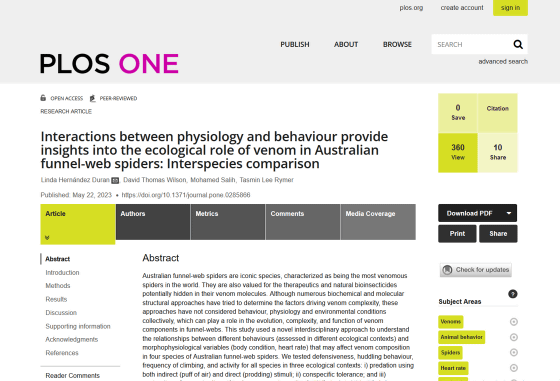Research results that the poison released by dangerous poisonous spiders that can kill humans changes its ingredients depending on the situation

Interactions between physiology and behavior provide insights into the ecological role of venom in Australian funnel-web spiders: Interspecies comparison | PLOS ONE
https://doi.org/10.1371/journal.pone.0285866

Funnel-web spider venom varies - JCU Australia
https://www.jcu.edu.au/news/releases/2023/may/funnel-web-spider-venom-varies
The World's Deadliest Spider Can Tweak Its Venom Depending on Its Mood : ScienceAlert
https://www.sciencealert.com/the-worlds-deadliest-spider-can-tweak-its-venom-depending-its-mood
Funnel spiders, which are characterized by their funnel-shaped nests, contain a deadly poison called strongly acidic robustoxin, and are called the world's strongest poisonous spiders, along with the brown recluse spider and the black spider . .
Especially the famous Sydney funnel spider , at least 10 deaths have been reported by the 1980s. For some reason, funnel spider venom does not work against lizards and birds, which are natural enemies, but is toxic to primates such as humans and monkeys, and is known to be particularly lethal to children.

by
While funnel spider venom is deadly to humans, we know that it can also be applied to natural insecticides and heart disease treatments . Therefore, understanding how funnel spiders produce venom may help extract and use chemicals more efficiently.
Linda Hernandez-Durán, a biologist at James Cook University in Australia, said: 'Funnel spiders have some of the most complex venoms in nature, and their venom molecules have the potential to be hidden therapeutics and natural pesticides. 'Knowing how to manufacture the venom is a step towards unlocking this potential.'
Therefore, Durand et al.'s research team targeted four representative species of funnel spiders, Atrax robustus, Hadronyche valida , Hadronyche infensa , and Southern tree-dwelling , and venom secreted in various situations. We conducted a study to analyze the

by David Wilson
The researchers sprayed the spiders with air, poked them with tweezers, and placed them face-to-face with other spiders of the same species to imitate various situations that spiders encounter. In the meantime, we evaluated the spider's behavioral characteristics, estimated the metabolic rate by measuring the heart rate with a laser, collected the poison, and investigated the ingredients with a mass spectrometer.
Experimental results did not identify any effects of behavior or heart rate on venom composition in the three species, but confirmed that changes in behavior and heart rate also changed venom composition in Hadronyche valida. rice field. ``In the Border Ranges funnel-web (Hadronyche valida), the expression of several toxic components was associated with heart rate and defensive behavior,'' Durand said. It suggests that sex may be species-specific.'
In addition, this study also showed that defensive behavior and poison secretion when attacked have a metabolic cost. Therefore, it was suggested that poisonous spiders may reduce their behavior to compensate for metabolic costs when secreting venom to protect themselves.
“We are the first to show how specific toxic components are associated with behavioral and physiological variables, and demonstrate that these relationships are context-dependent,” Durand said. We have gained valuable insights for further exploration and understanding of the ecological role of toxins.'

Related Posts:







